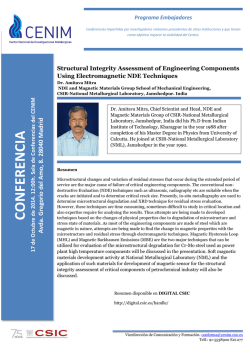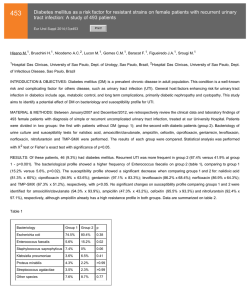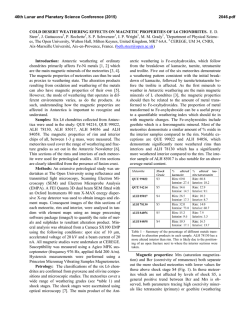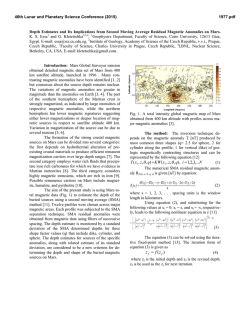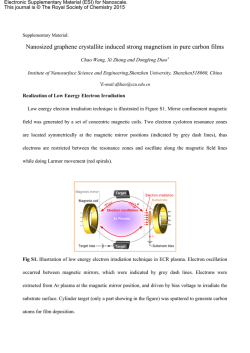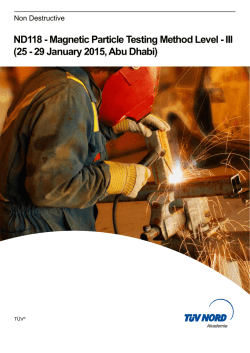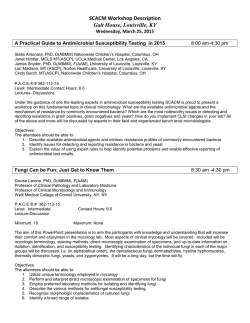
S tructure, magnetic susceptibility and resistivity
Journal of Alloys and Compounds 354 (2003) 95–98 L www.elsevier.com / locate / jallcom Structure, magnetic susceptibility and resistivity properties of SrVO 3 Y.C. Lan*, X.L. Chen, M. He Institute of Physics and Centre for Condensed Matter Physics, Chinese Academy of Sciences, Beijing 100080, PR China Received 7 February 2002; received in revised form 20 November 2002; accepted 26 November 2002 Abstract The crystallographic structure of the compound SrVO 3 has been determined by X-ray diffraction and refined by the Rietveld method. ˚ space group Pm3¯m, Z51. The electrical The structural analysis suggest SrVO 3 presents a cubic perovskite structure with a53.8425(1) A, resistivity measurement suggests metallic behavior for the oxide. Magnetic susceptibility measurement confirms that some trace impurities are still present in the nearly single phase specimen and affect the magnetic behavior of the samples. 2002 Elsevier Science B.V. All rights reserved. Keywords: Crystal structure; X-ray diffraction; Electrical transport 1. Introduction Strontium vanadate (SrVO 32d ) was first synthesized in the 1950s [1] and reported to be a cubic perovskite with a ˚ d 50–0.5 [2–4]. The cell parameter a53.840–3.849 A, oxide is a member of a family of metallic transition-metal (TM) oxides with the layered perovskite structure. Therefore SrVO 32d has been investigated as an ideal case for investigating the anomalous metallic properties near the Mott transition [5–7]. After the discovery of superconductivity in perovskite-like cuprate oxides [8], it is recognized [9,10] that the electronic configuration of V 41 with one 3d electron is analogous to the configuration (3d 9 ) of Cu 21 which has one 3d hole. Because of the above 3d 1 electronic configuration and its perovskite-like structure, SrVO 32d has been widely investigated during the 1990s [10–16] to search for new superconductors. Up to now, most research has indicated that the material shows a Pauli paramagnetic character and metallic behavior near room temperature. Additionally, the oxide is also a potential oxide electrical conductor [17,18] and has been given more attention in recent years. However it is very difficult to obtain a homogeneous, single-phase stoichiometric specimen because the Sr / V stoichiometry is fairly unstable [5] in the preparation *Corresponding author. Department of Physics, Temple University, Philadelphia, PA 19122, USA. Tel.: 11-215-204-7887; fax: 11-215-2045652. E-mail address: [email protected] (Y.C. Lan). process (an inert or reducing environment is always required). Small amount of impurities, such as Sr 8 V8 O 25 and other vanadium oxides, are still present in the specimens. The oxygen content is not easily controlled either. Therefore, the crystallographic structure was determined roughly. In this present work, we carefully synthesized good quality SrVO 32d specimens and determined the crystallographic structure. Electrical resistivity and magnetic susceptibility are also measured. Here we report the crystallographic study as well as the electrical and magnetic investigations of the compound SrVO 32d . 2. Experimental Samples were prepared by a solid-state reaction method using SrCO 3 (Alfa, 99.9% pure) and V2 O 5 (99.9% pure) powders as starting materials. The powders were mixed and ground stoichiometrically. The green mixture was calcined at 700 8C in air for 2 days with intermediate grindings. X-ray powder diffraction showed that the product at this stage contained Sr 3 V2 O 8 as an impurity phase. The calcined samples were reduced several times at 1000 8C in a flowing hydrogen atmosphere (|20 cc / min) with intermittent grinding and pelleting, and finally quenched to room temperature in protective ambience. Every time after the intermittent grinding, the reduced products were conveniently checked by examining X-ray diffraction patterns in order to avoid too much reduction. The process was repeated until no hexagonal compound 0925-8388 / 02 / $ – see front matter 2002 Elsevier Science B.V. All rights reserved. doi:10.1016 / S0925-8388(02)01349-X Y.C. Lan et al. / Journal of Alloys and Compounds 354 (2003) 95–98 96 Sr 8 V8 O 25 and other impurities can be determined from X-ray diffraction. The color of the sample turned to black after the completion of reduction. Some reduced sample tablets were directly used for electrical resistivity measurements or ground to powder for X-ray diffraction measurements. The crystal structure and the lattice constants of the reduced samples were determined by X-ray diffraction at room temperature using Cu Ka radiation on a Rigaku diffractometer equipped with the curved graphite monochromator. Silicon powder was used as an internal standard to determine the lattice parameters. The data were collected in the step scanning mode with steps of 0.028 (2u ). An angular range from 2u 520–1358 and a measuring time of 1 s / step were applied. The divergence, scattering, and receiving slits were set at 18, 18 and 0.1 mm, respectively. A total of 5751 points with a maximum count of 31 544 and 19 independent reflections were measured. The lattice parameters were calculated with the program TREOR90 [19]. The structure was refined by the Rietveld refinement method [20]. Electrical resistivity was measured in the temperature range of 4.2–300 K using a standard dc four-probe technique and the magnetic properties were studied with a commercial SQUID magnetometer. 3. Results and discussions 3.1. Crystal structure The observed powder diffraction data of SrVO 32d are given in Table 1. Interplanar spacings, hkl indices and Table 1 ˚ room temperature X-ray powder diffraction data. l 51.5406 A, 2u (8) I /I0 d ˚ (A) hkl 23.12 32.93 40.62 47.26 53.26 3 100 20 45 3 3.844 2.718 2.2192 1.9218 1.7185 1 1 1 2 2 58.81 69.08 73.94 78.68 83.34 40 25 2 16 5 1.5689 1.3586 1.2808 1.2151 1.1586 211 220 300,221 310 311 87.96 92.58 97.20 106.62 111.48 7 1 18 4 2 1.1093 1.0656 1.0269 0.9606 0.9320 222 320 321 400 410,322 116.54 121.82 127.42 133.45 10 3 10 1 0.9057 0.8815 0.8592 0.8385 330,411 331 420 421 0 1 1 0 1 0 0 1 0 0 relative intensities are also listed. The main diffraction peaks can be indexed using a cubic cell with lattice ˚ (the figure of merit [21] parameter a53.8425(1) A F(19)5106). The oxygen stoichiometry of the oxide was studied by thermogravimetric analysis (TGA), oxidizing the sample at 1100 8C in air. The oxygen content 32d of the obtained SrVO 32d samples is 3.00 within an experimental error of 60.05. The nearly single phase presents a structure isotypic with the so-called compounds SrVO 2.5 [1] and SrVO 2.88 [3]. The observed condition for reflection allows for the ¯ m, Pm3¯ and P23. Starting with space groups Pm3¯m, P43 ¯ Pm3m, the Sr and V atoms were located on the site 1a(0,0,0) and 1b(0.5,0.5,0.5), respectively, according to the ABO 3 cubic perovskite crystallographic structure. The oxygen atoms were set on the site 3c(0.5,0,0.5). The occupancy factor for oxygen was also refined. Using the computer program DBWS-9411 [22], the Rietveld refinement was carried out. The pseudo-Voigt function was used for the simulation of the peak shapes [23]. Intensities within 20 times of the full width at half maximum were considered to contribute to the reflection. Peaks below 758 were corrected for asymmetry effects. The analysis of powder patterns resulted in weak preferred orientation effects along [011], which was corrected using the March-Dollase function. The background was refined by a fifth-order polynomial. At the first step, scattering factor, zero point, background, profile parameters, and lattice constant were fitted. Oxygen content in a unit cell obtained from structural refinement is 3.060.1, which agreed with the experimental measurement from TGA. Under these conditions, successive refinements of the positional parameters of oxygen and the isotropic thermal parameters lead to R wp 57.49%, R exp 54.03%, S51.80. Attempts with other space groups only yielded larger agreement factors. Hence, the most probable space group is Pm3¯m. The results of the refinement are plotted in Fig. 1. Table 2 gives the structure parameters of the final refinement. 3.2. Electrical and magnetic properties Fig. 2 shows the temperature dependence of electrical resistivity r for SrVO 32d . The positive slope with increasing temperature indicates metallic conduction. The resistivity of SrVO 32d was about 41.8 mV?cm at room temperature and slightly decreased to 29.3 mV?cm at 4.2 K. In the entire temperature range, the electrical resistivity scales well as T 2 law r 5 r0 1 AT 2 with r0 529.2 mV?cm and A55.698310 25 mV?cm / K 2 , where T is temperature in Kelvin. The value of A is in accordance with those reported for single crystals [3,5]. The electrical resistivity ratio r300 K /r4.2 K for the sample is around 1.5, which is much lower than that for the single crystal ( r300 K /r4.2 K | 6) [24]. In the literature, polycrystalline samples always show a lower resistivity ratio than the single crystal samples [5,6,11,15]. It is generally accepted that the lower Y.C. Lan et al. / Journal of Alloys and Compounds 354 (2003) 95–98 97 Fig. 1. The final Rietveld refinement pattern of SrVO 32d . Small crosses represent the experimental values and solid lines the calculated pattern. The solid line at the bottom is the difference between the experimental and calculated values. The vertical markers show positions calculated for Bragg reflections. Table 2 Final Rietveld refinement parameters of SrVO 32d from X-ray powder diffraction data Atom Site x /a y /b z /c ˚ 2) B (A Sr V O 1a 1b 3c 0.0 0.5 0.5 0.0 0.5 0.0 0.0 0.5 0.5 0.6956 0.5323 0.9192 R wp 57.49%, R exp 54.03%. Fig. 2. Temperature dependence of electric resistivity of SrVO 32d . resistivity ratio is attributed to the porosity of the polycrystalline specimens. Despite the value of resistivity, all the samples prepared at different conditions by different authors show metallic behavior and possess a low electrical resistivity ( r is usually several mV?cm, not higher than 100 mV?cm at room temperature) [3,5,6,11,15,24]. The non-stoichiometric oxygen has no significant influence on the metallic properties of the compound. The temperature dependence of the magnetic susceptibility x is shown in Fig. 3. Susceptibility increases with decreasing temperature and saturates below 100 K. In other words, the susceptibility is a constant in the range of 4.2–100 K. This anomalous behavior of the susceptibility is an intrinsic characteristic of SrVO 3 , probably caused by the helical magnetic structure as in Co 2 ScSn alloy [25], or non-intrinsic properties caused by undetected impurities in the specimens. In order to investigate the origin of the extraordinary behavior, we measured the DC magnetic susceptibility up to 2T while increasing and decreasing the applied magnetic field H at different temperatures, such as at 4.2, 77 and 300 K. From the isothermal x –H curves, we found that the total magnetization is attributed to two terms: paramagnetic moments of SrVO 3 and antiferromagnetic moments of impurities. Below 100 K, with decreasing temperature, the decreasing susceptibility from antiferromagnetic impurities counteracts the increasing susceptibility of the paramagnetic phase, resulting in the nearly constant susceptibility with temperature. Since nonstoichiometric V2 O 31x shows a temperature-induced paramagnetic to antiferromagnetic phase transition in the 10–170 K range (the transition temperature depends on the oxygen content 31x) [26,27], it is reasonable to suppose the antiferromagnetic term comes from nonstoichiometric vanadium oxide impurities which is insufficiently reacted in the experiment. 98 Y.C. Lan et al. / Journal of Alloys and Compounds 354 (2003) 95–98 Acknowledgements The authors are very grateful to Dr. C.L. Chen for valuable discussion about the explanation of the magnetic properties. The investigations were supported by the Chinese Academy of Sciences and the National Natural Science Foundation of China. References Fig. 3. Temperature dependence of magnetic susceptibility x of SrVO 32d . In the literature, a magnetic anomaly at about 100 K was reported [28,29]. The anomaly was generally attributed to the impurities in the specimens, not the intrinsic nature of the compound [29]. If we remove the contribution of antiferromagnetic phases, the intrinsic component of the susceptibility will increase with decreasing temperature and show paramagnetic behavior, as reported in Refs. [5,17,29]. 4. Conclusion The nearly single phase SrVO 32d specimens are synthesized carefully through a hydrogen reduction route at 1000 8C. The crystal structure of the compound SrVO 32d is determined by X-ray powder diffraction and refined using Rietveld method. It is a cubic perovskite-like struc˚ (the figure of merit F(19)5106) ture with a53.8425(1) A ¯ and space group Pm3m. The electrical measurement shows SrVO 32d is metallic in the whole temperature range from 4.2 to 300 K. Though X-ray diffraction shows the prepared specimens are single phase samples, magnetic measurements indicates that trace impurities are still present in the specimens and affect the magnetic properties at low temperatures. The impurities cause a constant susceptibility in the 4.2–100 K temperature range. [1] M.J. Kestigian, J.G. Dickinson, R. Ward, J. Am. Chem. Soc. 79 (1957) 5598. [2] K.-J. Range, F. Rau, U. Klement, Z. Naturforsch. B 46 (1991) 1315. [3] M.J. Rey, Ph. Dehaudt, J.C. Joubert, B. Lambert-Andron, M. Cyrot, F. Corot-Lackmann, J. Solid State Chem. 86 (1990) 101. [4] J. Garcia, J.L. Mesa, M. Insausti, J.I.R. Larramendi, M.I. Arriortua, T. Rojo, Mater. Res. Bull. 34 (1999) 289. [5] I.H. Inous, O. Goto, H. Makino, N.E. Hussey, M. Ishikawa, Phys. Rev. B 58 (1998) 4372. [6] M. Itoh, M. Shikano, H. Kawaji, T. Nakamura, Solid State Commun. 80 (1991) 545. [7] Y. Aiara, F. Iga, Y. Nishihara, H. Ohnuki, H. Kato, Phys. Rev. B 47 (1993) 6732. ¨ [8] J.G. Bednorz, K.A. Muller, Z. Phys. B 64 (1986) 189. [9] W.E. Pickett, D. Singh, D.A. Papaconstantopoulos, H. Krakauer, M. Cyrot, F. Cyrot-Lackmann, Physica C 162 (1989) 1433. [10] M. Cyrot, B. Lambert-Andron, J.L. Soubeyrous, M.J. Rey, Ph. Dehaudt, F. Cyrot-Lackmann, G. Fourcaudot, J. Beille, J.L. Tholence, J. Solid State Chem. 85 (1990) 321. [11] A. Fujimori, K. Kawakami, N. Tsuda, Phys. Rev. B 38 (1988) 7889. [12] B. Vom Hedt, K. Westerholt, H. Bach, Physica C 172 (1990) 123. [13] J.W. Allen, C.G. Olson, M.B. Maple, J.S. Kang, L.Z. Liu, J.H. Park, R.O. Anderson, W.P. Ellis, J.T. Market, Y. Dalichaouch, R. Liu, Phys. Rev. Lett. 64 (1990) 595. [14] F. Deslandes, A.I. Nazzi, J.B. Torrance, Physica 179 (1991) 85. [15] A. Nozaki, H. Yoshikawa, T. Wada, H. Yamauchi, S. Tanaka, Phys. Rev. B 43 (1991) 181. [16] I.H. Inoue, H. Makino, I. Hase, M. Ishikawa, N.E. Hussey, M.J. Rozenberg, Physica B 237 / 238 (1997) 61. [17] B.L. Chamberland, P.S. Danielson, J. Solid State Chem. 3 (1971) 243. [18] V. Giannakopoulou, P. Odier, J.M. Bassat, J.P. Loup, Solid State Commun. 93 (1995) 579. [19] A. Boultif, D. Louer, J. Appl. Crystallogr. 24 (1991) 987. [20] H.M. Rietveld, J. Appl. Crystallogr. 2 (1969) 65. [21] G.S. Smith, R.L. Snyder, J. Appl. Crystallogr. 12 (1979) 60. [22] R.A. Young, A. Sakthivel, T.S. Moss, C.O. Paiva-Santos, J. Appl. Crystallogr. 28 (1995) 366. [23] P.E. Werner, L. Eriksson, M. Westdahl, J. Appl. Crystallogr. 18 (1985) 367. [24] D.R. Ardila, J.P. Andreeta, H.C. Basso, J. Cryst. Growth 211 (2000) 313. [25] C.L. Lin, T. Mihalisin, N. Bykovetz, J. Magn. Magn. Mater. 116 (1992) 355. [26] Y. Ueda, K. Kosuge, S. Kachi, H. Yasuoka, H. Nishihara, A. Heidemann, J. Phys. Chem. Solids 39 (1978) 1281. [27] M. Nakahira, S. Horiuchi, H. Coshima, J. Appl. Phys. 41 (1970) 836. [28] P. Dougier, J.C.C. Fan, J.B. Goodenough, J. Solid State Chem. 14 (1975) 247. [29] M. Onoda, J. Ohta, H. Nagasawa, Solid State Commun. 79 (1991) 281.
© Copyright 2026
